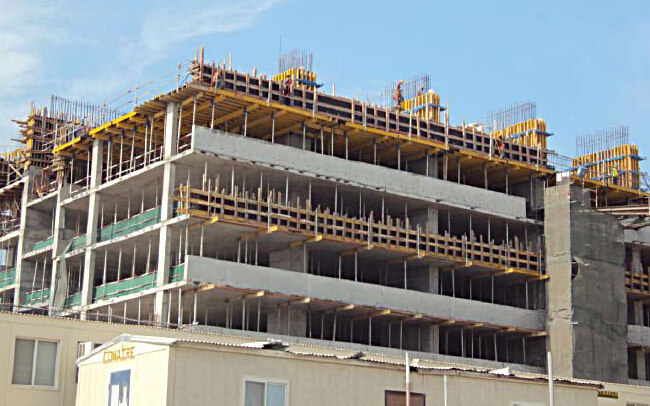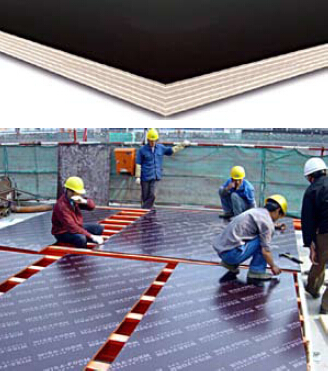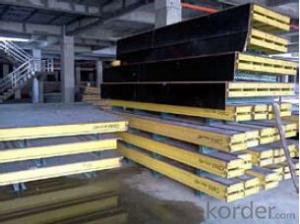Plywood formwork system and scaffolding system
- Loading Port:
- Tianjin
- Payment Terms:
- TT OR LC
- Min Order Qty:
- 50 g/m²
- Supply Capability:
- 1000 g/m²/month
OKorder Service Pledge
Quality Product, Order Online Tracking, Timely Delivery
OKorder Financial Service
Credit Rating, Credit Services, Credit Purchasing
You Might Also Like
Plywood --- make perfect concrete surface
WISA-Form Birch is a coated special plywood using in the formwork systems where high
requirements are set on the concrete surface and the times of reuses.
With CNBM timber beam & WISA plywood, the formwork is low weight but high load capacity, it is
widely used in construction.
Characteristics:
◆ Component with high standardization.
◆ Assembling in site, flexible application.
◆ Light weight, easy transportation and storage.


- Q:How does steel formwork affect the overall water tightness of a structure?
- Steel formwork can have a significant impact on the overall water tightness of a structure. When used in construction, steel formwork provides a strong and rigid support system for casting concrete, enabling the creation of complex shapes and structures. However, steel formwork is not fully water tight and can allow water to penetrate through the joints, gaps, or imperfections in the formwork system. If not properly sealed or adequately reinforced, the use of steel formwork can compromise the water tightness of a structure. Water infiltration can lead to a variety of issues, including dampness, mold growth, corrosion of embedded steel reinforcement, and degradation of the concrete. These problems can weaken the structure over time, reducing its durability and lifespan. To mitigate the impact of steel formwork on water tightness, several measures can be taken. Firstly, proper jointing and sealing techniques should be employed to minimize gaps and ensure a tight fit between formwork elements. This can involve using sealants, gaskets, or waterproofing membranes to prevent water infiltration. Additionally, reinforcing the formwork with additional waterproofing layers, such as bituminous coatings or polyethylene sheets, can enhance water resistance. It is also essential to regularly inspect and maintain the formwork system to identify any potential water leakage points and address them promptly. Proper curing of the concrete is crucial to prevent shrinkage cracks that may compromise the water tightness of the structure. Applying appropriate surface treatments, such as waterproofing paints or coatings, can further enhance the water resistance of the concrete. In conclusion, while steel formwork may not be inherently water tight, its impact on the overall water tightness of a structure can be effectively managed through the implementation of proper jointing, sealing, and reinforcement techniques. By taking these precautions and conducting regular maintenance, the water tightness of the structure can be significantly improved, ensuring its long-term durability and integrity.
- Q:How does steel formwork contribute to the overall structural integrity of the building?
- Steel formwork contributes to the overall structural integrity of the building by providing a strong and durable framework for concrete construction. It ensures accurate and precise alignment of walls, columns, and beams, resulting in a structurally sound and stable building. The steel formwork system is capable of withstanding heavy loads and forces during construction and enhances the overall strength and stability of the structure. Additionally, the use of steel formwork allows for easy and efficient construction, reducing construction time and costs while ensuring high-quality and long-lasting buildings.
- Q:How much time does it take to install steel formwork?
- The amount of time it takes to install steel formwork can vary depending on several factors such as the size and complexity of the project, the level of experience and skill of the workers, and the availability of necessary equipment and resources. However, on average, the installation of steel formwork can take anywhere from a few hours to a few days. Smaller and simpler projects may be completed relatively quickly, while larger and more intricate projects may require more time and effort. It is important to carefully plan and coordinate the installation process, considering factors such as the number of formwork panels, their size and weight, and the necessary support systems. Additionally, factors such as weather conditions and site-specific challenges may also impact the time required for installation.
- Q:What are some of the components of the combined steel template, what role?
- Two, the main equipment1, mechanical equipment, drill, grinding wheel cutting machine, according to the circular machine, electric wrenches and welding equipment, etc..2, the main tool hammer, iron ruler, steel ruler, wrench, wire brush, brush. Drums, crowbar, screwdriver, theodolite, level. Tower ruler.
- Q:What are the considerations when designing steel formwork for architectural canopies?
- When designing steel formwork for architectural canopies, several considerations need to be taken into account. Firstly, the structural integrity and load-bearing capacity of the steel formwork should be carefully calculated to ensure it can withstand the expected loads and forces. Additionally, the formwork should be designed to be easily assembled and disassembled, allowing for efficient installation and removal. The formwork should also be designed to accommodate any necessary openings or cutouts for lighting fixtures or other architectural elements. Finally, aesthetic considerations such as the finish and appearance of the steel formwork should be taken into consideration to ensure it complements the overall design of the canopy.
- Q:Can steel formwork be easily modified or adjusted during concrete placement?
- Yes, steel formwork can be easily modified or adjusted during concrete placement. Steel formwork is known for its versatility and flexibility, allowing for easy modifications or adjustments as per the requirements of the concrete structure. Steel formwork systems are typically designed with adjustable components such as panels, beams, and props, which can be easily repositioned or moved to accommodate changes in the design or dimensions of the concrete structure. These adjustable components can be quickly and securely locked into place, providing stability and support during concrete placement. Additionally, steel formwork allows for the use of various formwork accessories such as clamps, connectors, and ties, which further enhance its adaptability and ease of modification. Overall, steel formwork provides a highly efficient and flexible solution for adjusting or modifying formwork during concrete placement.
- Q:How does steel formwork contribute to the overall speed of construction?
- Steel formwork contributes to the overall speed of construction by providing a durable and reusable solution for creating concrete structures. The use of steel formwork allows for faster and more efficient construction processes as it can be easily assembled and disassembled, reducing the time required for formwork installation and removal. Additionally, steel formwork provides a smooth and consistent surface, resulting in faster curing times and improved productivity.
- Q:Can steel formwork be used in areas with high wind uplift forces?
- Yes, steel formwork can be used in areas with high wind uplift forces. Steel formwork is known for its strength and durability, making it a suitable choice for construction projects in areas that experience high wind uplift forces. The steel formwork system can be designed to withstand these forces by incorporating additional reinforcement and bracing to ensure stability and prevent any potential damage or failure. Engineering calculations and structural analysis can be conducted to determine the specific requirements for the steel formwork in order to withstand the high wind uplift forces. Additionally, proper installation and anchoring techniques should be employed to further enhance the resistance of the steel formwork system against these forces.
- Q:How does steel formwork handle different concrete surface gloss levels?
- Steel formwork is a versatile and durable option for dealing with different levels of gloss on concrete surfaces. Its ability to create a consistent and even finish is due to its smooth and rigid nature. When it comes to achieving different levels of gloss on concrete surfaces, steel formwork has several advantages. Firstly, it offers a smooth and uniform surface, which is crucial for achieving a high gloss finish. The steel panels are meticulously constructed to create a seamless surface, minimizing any irregularities that could affect the desired gloss level. In addition, steel formwork is highly resistant to warping or bending under the weight of the concrete. This ensures that the surface remains level and consistent, which is particularly important when aiming for a glossy finish. Any inconsistencies in the formwork could lead to uneven concrete placement and variations in gloss. Moreover, steel formwork is reusable, making it cost-effective and environmentally friendly. With proper maintenance and care, it can be used for multiple projects, ensuring consistent results in terms of gloss levels. In conclusion, steel formwork is an excellent choice for handling different levels of gloss on concrete surfaces. Its smooth and rigid construction guarantees a uniform finish, while its durability ensures consistent results. Steel formwork provides an efficient and effective solution for achieving various gloss levels in concrete construction projects.
- Q:Can steel formwork be used for both single-sided and double-sided forming?
- Steel formwork is capable of being utilized for both single-sided and double-sided forming. Renowned for its strength and durability, steel formwork is well-suited for various construction applications. In the case of single-sided forming, the steel panels are firmly secured against a solid surface or pre-existing structure, acting as a barrier to retain the concrete until it solidifies. Conversely, for double-sided forming, steel formwork panels are employed on both sides of the concrete pour, creating a mold that holds the concrete in place and provides a sleek finish on both sides of the structure. The versatility of steel formwork permits its utilization in a wide array of construction projects, encompassing walls, columns, beams, slabs, and more.
1. Manufacturer Overview |
|
|---|---|
| Location | |
| Year Established | |
| Annual Output Value | |
| Main Markets | |
| Company Certifications | |
2. Manufacturer Certificates |
|
|---|---|
| a) Certification Name | |
| Range | |
| Reference | |
| Validity Period | |
3. Manufacturer Capability |
|
|---|---|
| a)Trade Capacity | |
| Nearest Port | |
| Export Percentage | |
| No.of Employees in Trade Department | |
| Language Spoken: | |
| b)Factory Information | |
| Factory Size: | |
| No. of Production Lines | |
| Contract Manufacturing | |
| Product Price Range | |
Send your message to us
Plywood formwork system and scaffolding system
- Loading Port:
- Tianjin
- Payment Terms:
- TT OR LC
- Min Order Qty:
- 50 g/m²
- Supply Capability:
- 1000 g/m²/month
OKorder Service Pledge
Quality Product, Order Online Tracking, Timely Delivery
OKorder Financial Service
Credit Rating, Credit Services, Credit Purchasing
Similar products
New products
Hot products
Related keywords

























